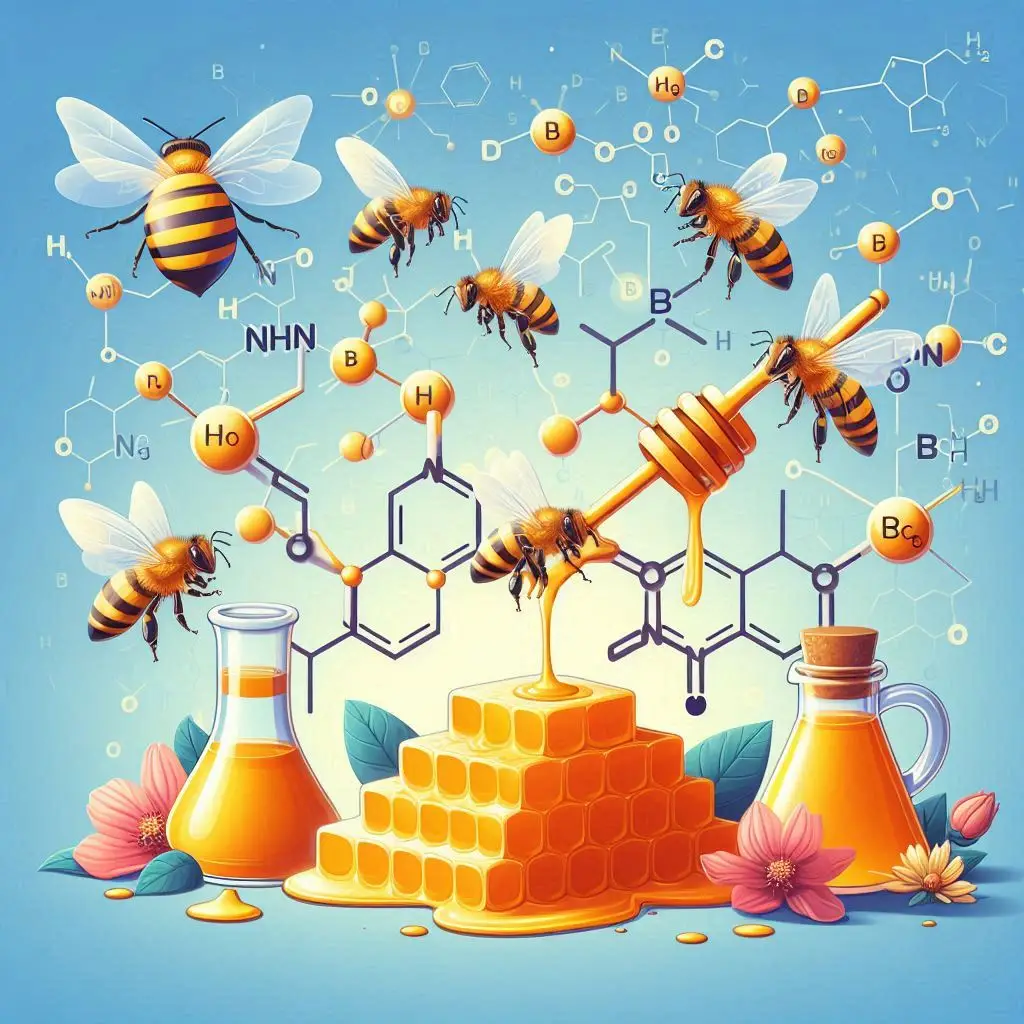
what is the chemical composition of honey
In this essay, what is chemical composition of honey, I'll go into detail on the main, minor, and trace elements that make up honey's chemical makeup. We will also talk about the importance of these elements for both the bees that make honey and the people who eat it.
Honey is a naturally sweet material that honeybees make by gathering and processing floral nectar. It is a fascinating natural substance whose intricate chemical make-up gives it its distinct flavor, scent, and a host of health advantages.
Honey is mostly made up of carbohydrates, with sugars making up more than 80% of its dry weight. Glucose and fructose, which together account for around 95% of the honey's total carbohydrate content, are the two main sugars. These simple sugars are what give honey its distinctive sweetness. varied varieties of honey may have varied glucose to fructose ratios, which can affect taste and crystallization propensities. Smaller levels of maltose and sucrose are also present in honey.
Honey has a variety of other ingredients in addition to sugars that help to give it its special qualities. Water, which makes up between 15 and 20% of honey's makeup, is one of them, along with a number of organic acids, amino acids, proteins, and enzymes. Honey's acidic pH, which is typically about 3.9, is caused by the presence of tiny quantities of organic acids such acetic acid, citric acid, and formic acid.
Additionally, honey contains a number of vitamins and minerals. Despite being present in very modest amounts, they are nevertheless important. Vitamins including vitamin C, B-complex vitamins like niacin, riboflavin, and pantothenic acid, as well as trace levels of vitamin A, are all present in honey. Honey contains trace amounts of calcium, iron, magnesium, phosphorus, potassium, and zinc among other minerals. These vitamins and minerals are part of the nutritional value and health advantages of honey.
The presence of antioxidants in honey is one of its most impressive qualities. Flavonoids and phenolic compounds are only a few of the natural antioxidants that honey is known to have. These anti-oxidants extend the shelf life of the honey and keep it from going bad. Additionally, by battling oxidative stress and lowering the risk of chronic illnesses, these antioxidants may boost human health when taken.
Depending on the flower source, honey may have a broad range of colors and smells. Honey's taste and scent are influenced by the VOCs that make up its makeup. The chemicals produced by nectar-producing plants and the bees' enzymatic activity during honey synthesis give honey its distinctive fragrance. For instance, honey from orange blooms or wildflowers will have a distinct scent and taste character than honey from lavender meadows.
The content and characteristics of honey are greatly influenced by enzymes. Bees create the enzymes necessary to break down sucrose and nectar's carbohydrates into glucose and fructose, respectively. This reaction requires the enzyme invertase. Other enzymes that contribute to honey's antibacterial effects include glucose oxidase, which is found in honey and creates hydrogen peroxide. Due to the inactivation of these enzymes during storage, honey has a long shelf life.
Pollen is another essential component of honey. Honey naturally contains trace quantities of pollen, which makes it a possible source of allergies. When drinking honey, those with pollen allergies should exercise caution since even minute amounts of pollen may cause allergic responses. Regulations in several nations demand that honey labels state if pollen is present for allergy awareness.
The amount of water in honey has a significant impact on its stability and deterioration resistance. Bacteria and yeast cannot develop because of the low water content, which is often around 20%. Due to its low water content, honey is naturally preserved because of its resistance to fermentation and spoiling.
Honey's capacity to crystallize is one of its most interesting properties. Over time, honey may transition from a liquid form to a semi-solid or solid state. The floral source, temperature, and the presence of suspended particles are a few of the variables that affect the pace and pattern of crystallization. Natural processes like crystallization do not signify deterioration or a drop in quality. Honey that has crystallized may be gently heated to bring it back to its liquid condition, but excessive heating should be avoided to protect the taste and fragrance.
Honey is a genuinely amazing natural substance with a sophisticated chemical make-up. Sugars, particularly glucose and fructose, make up its main components and are what give it its sweetness. Additionally, honey includes water, volatile chemical compounds, organic acids, amino acids, proteins, and enzymes. Together, these elements give honey its distinct taste, fragrance, and health advantages.
Honey has natural antioxidants that may help fight oxidative stress and lower the chance of developing chronic illnesses, making it a possible addition to a healthy diet. Its low water content and acidic pH prevent microbe development, extending its shelf life and providing natural preservation characteristics.
Honey serves an important purpose for honeybees in addition to being a product of interest to humans. For bees, honey is their main source of energy, particularly in the winter when nectar is limited. The procedure of nectar gathering, processing, and honey generation is proof of the bees' extraordinary skills and their contribution to ecosystem pollination.
The complex biological processes of nature and the co-evolution of plants and pollinators are shown by the chemical makeup of honey. Its many ingredients, which range from sugars to antioxidants, provide gastronomic as well as possible health advantages. Understanding the ingredients in honey not only helps us appreciate this healthy sweetener more, but it also emphasizes how important honeybees are to the health of our environment.

